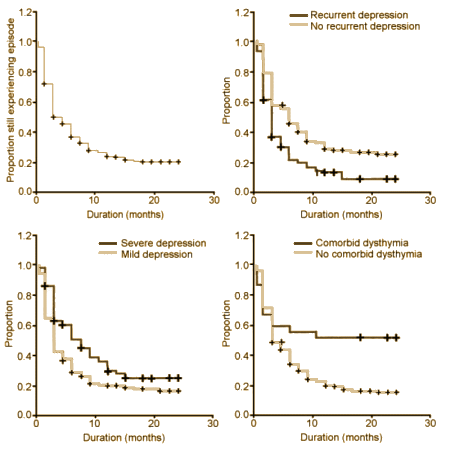Duration of major depressive episodes in the general population: results from The Netherlands Mental Health Survey and Incidence Study [NEMESIS]
by JAN SPIJKER, MD, RON de GRAAF PhD, ROB V. BIJL PhD WODC, AARTJAN T. F. BEEKMAN MD PhD, JOHAN ORMEL PhD, WILLEM A. NOLEN PhD
The British Journal of Psychiatry (2002) 181: 208-213
Background Data on the duration of major depressive episodes (MDE) in the general population are sparse.Aims To assess the duration of MDE and its clinical and socio-demographic determinants in a study group drawn from the general population with newly originated episodes of major depression.Method The Netherlands Mental Health Survey and Incidence Study is a prospective epidemiological survey in the adult population (n=7076), using the Composite International Diagnostic Interview.Results The median duration of MDE was 3.0 months; 50% of participants recovered within 3 months, 63% within 6 months, 76% within 12 months and nearly 20% had not recovered at 24 months. Determinants of persistence were severity of depression and comorbid dysthymia. A recurrent episode predicted shorter duration.Conclusions Although half of those affected with MDE recovered rapidly, the risk of chronicity (duration 24 months or more) was considerable. This underlines the necessity of diagnosing and treating those at risk.

Comorbid Dysthymia: the short form is "gloomy people" – always more or less of depressed.
Probably the greatest fall-out from the Pharmaceutical Industry’s invasion into Psychiatry is that it’s hard to know what to believe – not just for patients, but for those of us involved in treatment. It’ll be easy to ignore iSPOT if it turns out to be what it looks like it is now. But when you find yourself questioning an NIMH study like STAR*D, it’s hard to know where to turn for credible information.
Mental Illness is confusing enough in its own right. We sure don’t need a lot of jury-rigged science further muddying the water…
That is all that needs to be said, thank you for saying it